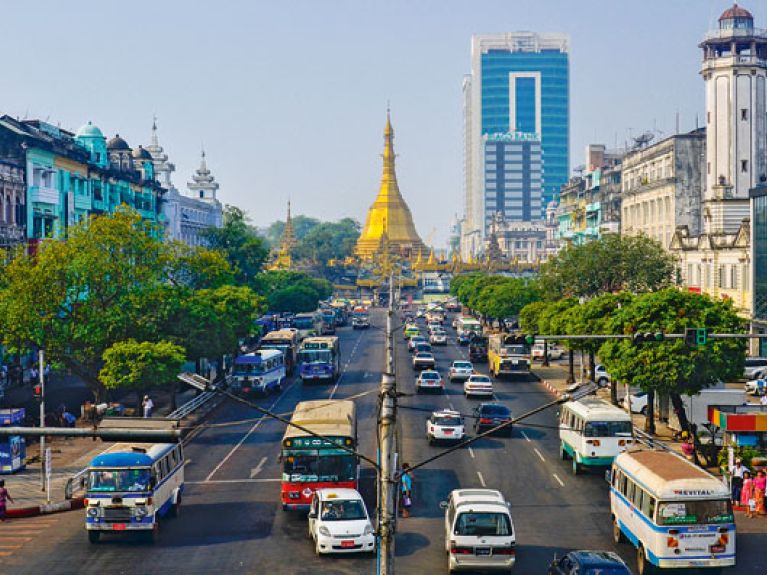“Myanmar is something special”
Myanmar has taken a development trajectory all of its own. Where is it leading? An interview with Monika Staerk, Delegate of German Industry and Commerce in Myanmar.

Ms Staerk, you have been representing German industry and commerce in Myanmar for two-and-a-half years now. To what extent have they locked into the upswing?
The number of German investors is still very low. But that is something we’re familiar with from other Asian countries at comparable stages of development. One of the Germans’ main activities is supply – of consumer goods and upstream products, but primarily of industrial goods. We are also involved in very exciting purchasing activities – in the clothing sector and in the field of processed agricultural products, and we are also venturing into simple industrial goods. There are a good 40 German companies registered in Myanmar, but the number of German firms that regularly come here from other Asian locations with their distribution partners to visit clients is far higher. The German Myanmar Business Chamber, which works hand in hand with the delegation, has over 70 members.
Could you give us an example of a successful German company?
I don’t want to single out any one company, but I can certainly mention the longstanding pioneers – for example, the Hamburg-based shipping company Uniteam. It has been operating in the country for decades now, among other things, training seamen. Nivea has also had a presence here for a long time and is a leading brand. Henkel has had detergent produced here for the local market since 2014. BMW and Mercedes, and recently VW as well, are marketed by local partners. And the major filling plants and breweries in the country use tried and tested German equipment. Siemens has been here for years – other DAX-listed companies such as BASF, Bayer, and ThyssenKrupp followed. And you’ll also find the big names in German logistics in Myanmar. I could carry on.
In which areas do you still see potential for German companies?
With the current state of the market there is potential in almost all areas – most directly in consumer goods production, in printing and packaging, as well as in construction, infrastructure and energy. But patience is the name of the game when it comes to establishing German quality and resource efficiency in the price-sensitive Myanmar market.
What are the general conditions like, and where is there still a need for reform?
One problem is certainly restrictions in retail and distribution, which are only open to purely local firms. This means that German companies interested in supplying have to work with local distribution partners. There are quite simply not enough of them, however, especially when it comes to German capital goods, which need a lot of explanation, and overall with regard to more sophisticated and higher-priced products. This bottleneck makes it more difficult for lots of German companies to enter the market. Furthermore, human resources is without doubt the biggest challenge in Myanmar. You hear these complaints in other Asian countries as well, but Myanmar’s long isolation from the West has left a particularly deep mark. After all, a customer group of local industrial companies has not yet developed. Local firms still have a lot of catching up to do in terms of quality and productivity, but their poor access to finance means they are only able to invest in German machinery to a limited extent. There is already a lot of German equipment in foreign investors’ plants in the oil and gas industries and in the consumer goods sector.
Can you put the current economic development in figures?
I could make things easy for myself and say that Myanmar is the fastest-growing country in the Asia-Pacific region. International organisations are assuming GDP growth rates of between 7 and 8.5% for the next few years. But this trend starts from a very low base level. Per capita GDP has not yet reached 1,400 US dollars – and wealth is unevenly distributed. The fact the country was cut off from the West for so long is noticeable when it comes to the volume of investment. A large proportion of the almost 64 billion US dollars came from China. The growth in approved projects, worth 9 billion US dollars in the last financial year, is certainly modest by regional standards. At the moment, the country is unable to absorb more. A lot will depend on the quality and sustainability of growth. A fast boom was never in sight – and the new government does not want one anyway.
On your website you refer to Myanmar as “the friendliest country in Asia, if not the world”. What is Myanmar like?
The people show a friendliness that is natural, not at all artificial. They are very open and uncomplicated in their communication – and show patient lenience with clueless foreigners. People’s pride in their country is noticeable. They don’t want to copy their Asian neighbours – neither Singapore nor China – or submit blindly to the achievements of Western or global consumerism. The people, lots of people, insist on their particular idiosyncrasies. Where can you still find that today, a country that affords itself the luxury of being different? It has its price as far as rapid growth is concerned. But it has a specific quality. In ten years we’ll know whether Myanmar wilfully chose a special development path, or whether global standardisation prevailed. It is a privilege to be able to witness this unique experiment. ▪
Interview: Martin Orth

